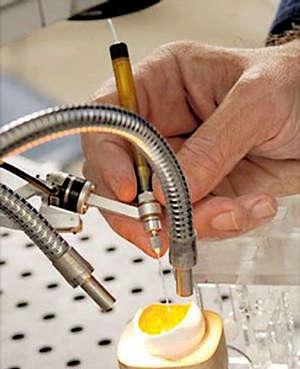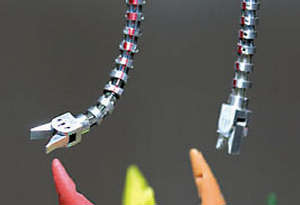Cool technology
One of the trade journals I really like is
Machine Design. They have a lot of interesting articles about emerging technology and I look forward to each issue.
This months issue has a short piece on some work being done at Johns Hopkins University for Surgeons. All people have some kind of tremor in their hands and what these researchers are doing is to try and develop a robot that the surgeon would grip. The instrument (scalpel or syringe) would be on the other end and the robot would sense and damp out the surgeons tremor allowing for a much greater degree of precision.
From
Machine Design:
Robot could steady surgeon's hand
A snakelike robot could help surgeons make incisions and tie sutures with greater precision. A second robot, the steady-hand, may curb a surgeon's natural tremor and let the doctor inject drugs into tiny blood vessels in the eye, dissolving clots that can damage vision.
The robots are being perfected at the National Science Foundation Engineering Research Center at Johns Hopkins University. "Human hands are remarkable, but they have limitations. There are times it would be useful to have a third hand, and we can provide that. Sometimes a surgeon's fingers are too large to work in a confined space within the body. We can help by building tools that act like tiny, highly dexterous hands," says Russell H. Taylor, a professor of computer science and director of the center.
One potential use for the team's snakelike robot is in throat surgery. Currently, a doctor must insert and manually manipulate long inflexible tools and a camera into this narrow passageway. The snakelike robot, in contrast, could enter the throat, its two thin rods carrying tools at their tips. Capable of six degrees of freedom, the tools easily bend into an S-curve.
During surgery, a doctor at a workstation would see a three-dimensional view of the operating site while guiding the robot. The tools' movements are nimble, thanks to sophisticated software that can make up to 100 adjustments/sec.
The steady-hand system was built to help with another challenging task: microsurgery. At this scale, even the best surgeons display some tremor in their hands. Yet the slightest uncontrolled movements can be troublesome during surgery on microscopic structures. To address this problem, the steady-hand robot can grasp a needle and move it carefully in tandem with the surgeon in a technique called cooperative manipulation.
Before they are used on human patients, both the snakelike robot and the steady-hand system will need perhaps five more years of lab testing and prototyping. Still, Taylor believes both have a good chance of eventually joining more traditional tools in hospital operating rooms.


Very cool -- and this is just the beginning of such tools...
Posted by DaveH at February 28, 2007 8:56 PM

